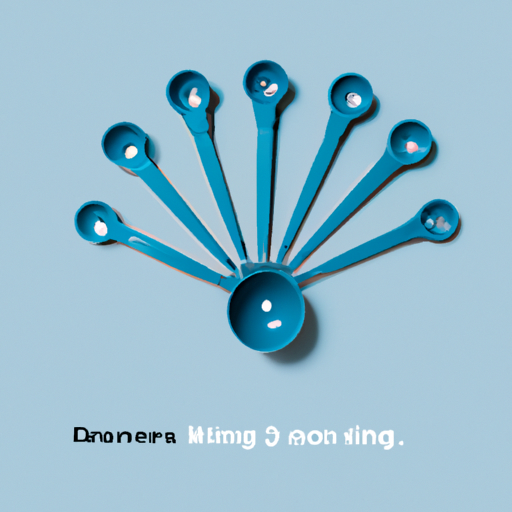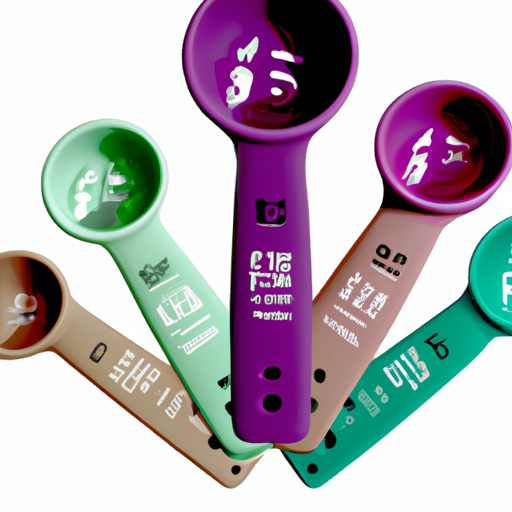Are you tired of constantly searching for conversions while cooking? Look no further! The Cooking Measures Conversion Chart is here to simplify your cooking experience. This handy chart provides easy-to-read and comprehensive conversions for various cooking measures, allowing you to easily convert ingredients from cups to grams, tablespoons to milliliters, and much more. Say goodbye to recipe mishaps and hello to precision in your cooking. With the Cooking Measures Conversion Chart by your side, you’ll never have to worry about inaccurate measurements again.

Cooking Measures Conversion Chart
Welcome to the ultimate guide for cooking measures conversion! Whether you’re a novice in the kitchen or an experienced cook, this comprehensive chart will come in handy when you need to convert between different measurements. From cups to ounces, teaspoons to milliliters, and Fahrenheit to Celsius, we’ve got you covered. So, grab your apron and let’s dive into the world of measurement conversions!
US Standard Volume Measurements
Cups to Tablespoons
Do you ever find yourself in the middle of a recipe, only to realize that you need to convert cups to tablespoons? Don’t worry, we’ve got a simple conversion for you. One cup is equal to 16 tablespoons. So, if a recipe calls for 2 cups, you’ll need 32 tablespoons.
Tablespoons to Teaspoons
Tablespoons and teaspoons are commonly used in cooking, and it’s important to know how to convert between the two. There are three teaspoons in one tablespoon. So, if a recipe instructs you to add 3 tablespoons of an ingredient, you’ll need 9 teaspoons.
Cups to Fluid Ounces
When it comes to converting between cups and fluid ounces, it’s useful to know that 1 cup is equal to 8 fluid ounces. So, if a recipe calls for 2 cups of water, you’ll need 16 fluid ounces.
Fluid Ounces to Milliliters
Converting fluid ounces to milliliters can be a bit trickier, but fear not! One fluid ounce is approximately 29.57 milliliters. So, if a recipe requires 10 fluid ounces of milk, you’ll need around 295.7 milliliters.
Pints to Cups
If you have a recipe that calls for pints but you prefer to work with cups, we have you covered. There are 2 cups in one pint. So, if a recipe requires 4 pints of stock, you’ll need 8 cups.
Quarts to Pints
When a recipe calls for quarts, but you only have pints on hand, you’ll need to convert the measurements. Luckily, there are 2 pints in one quart. So, if a recipe instructs you to use 3 quarts of water, you’ll need 6 pints.
Gallons to Quarts
Converting from gallons to quarts may seem daunting, but it’s a straightforward calculation. There are 4 quarts in one gallon. So, if a recipe calls for 2 gallons of vegetable oil, you’ll need 8 quarts.
Metric Volume Measurements
Milliliters to Teaspoons
Metric volume measurements can be a bit different, but once you have the conversion figures, it becomes much simpler. One milliliter is approximately equal to 0.2 teaspoons. So if a recipe requires 10 milliliters of vanilla extract, you’ll need around 2 teaspoons.
Liters to Milliliters
When converting between liters and milliliters, keep in mind that there are 1000 milliliters in one liter. So, if a recipe calls for 3 liters of water, you’ll need 3000 milliliters.
Liters to Cups
Converting from liters to cups is a handy skill to have in the kitchen. One liter is equal to approximately 4.23 cups. So, if a recipe instructs you to use 2 liters of milk, you’ll need around 8.46 cups.
Liters to Fluid Ounces
Converting from liters to fluid ounces can be a bit more challenging, but with the right conversion factor, it becomes much simpler. One liter is approximately equal to 33.81 fluid ounces. So, if a recipe requires 0.5 liters of olive oil, you’ll need approximately 16.91 fluid ounces.
Liters to Pints
If you prefer working with pints and have a recipe that provides measurements in liters, we have you covered. One liter is approximately equal to 1.76 pints. So, if a recipe calls for 1.5 liters of broth, you’ll need around 2.65 pints.
Liters to Quarts
Converting from liters to quarts requires a simple calculation. One liter is approximately equal to 1.06 quarts. So, if a recipe instructs you to use 2 liters of tomato sauce, you’ll need around 2.12 quarts.
Liters to Gallons
Converting from liters to gallons is useful when you have a recipe that provides measurements in liters but prefer using gallons. One liter is approximately equal to 0.26 gallons. So, if a recipe calls for 5 liters of water, you’ll need approximately 1.32 gallons.
US Standard Weight Measurements
Ounces to Grams
Converting between ounces and grams is crucial for precise measurements in the kitchen. One ounce is approximately equal to 28.35 grams. So, if a recipe requires 6 ounces of flour, you’ll need around 170.1 grams.
Pounds to Kilograms
When converting pounds to kilograms, remember that there are 2.2046 pounds in one kilogram. So, if a recipe calls for 3 pounds of beef, you’ll need around 1.36 kilograms.
Pounds to Ounces
If a recipe provides measurements in pounds, but you prefer working with ounces, we’ve got you covered. One pound is equal to 16 ounces. So, if a recipe instructs you to use 2 pounds of butter, you’ll need 32 ounces.

Metric Weight Measurements
Grams to Ounces
Converting grams to ounces is vital for precision in cooking. One gram is approximately equal to 0.035 ounces. So, if a recipe requires 500 grams of sugar, you’ll need around 17.64 ounces.
Kilograms to Pounds
Converting kilograms to pounds is a handy skill to have when you have a recipe that provides measurements in kilograms, but prefer working with pounds. One kilogram is approximately equal to 2.205 pounds. So, if a recipe calls for 1.5 kilograms of chicken, you’ll need approximately 3.31 pounds.
Kilograms to Grams
When converting kilograms to grams, keep in mind that there are 1000 grams in one kilogram. So, if a recipe instructs you to use 2.5 kilograms of rice, you’ll need 2500 grams.
Convert Between Volume and Weight
Cups to Grams
Converting between cups and grams is often required in baking. However, different ingredients have different conversion rates. For example, one cup of all-purpose flour is approximately 120 grams, while one cup of granulated sugar is approximately 200 grams. It’s essential to consult a specific conversion chart for precise measurements.
Cups to Ounces
Converting cups to ounces is helpful when you have a recipe that provides measurements in cups, but you prefer working with ounces. One cup is equal to 8 ounces. So, if a recipe calls for 2 cups of chocolate chips, you’ll need 16 ounces.
Grams to Cups
When converting grams to cups, it’s crucial to have a specific conversion chart for each ingredient. For example, 120 grams of all-purpose flour is roughly equal to one cup, while 200 grams of granulated sugar is approximately one cup.
Ounces to Cups
If you prefer working with cups and have a recipe that provides measurements in ounces, we have a conversion for you. One ounce is equal to 0.125 cups. So, if a recipe instructs you to use 8 ounces of cream cheese, you’ll need approximately 1 cup.
US Standard Temperature Measurements
Fahrenheit to Celsius
Converting between Fahrenheit and Celsius is essential when following recipes from different regions. To convert Fahrenheit to Celsius, subtract 32 from the Fahrenheit temperature, then multiply by 5/9. For example, if a recipe requires baking at 350°F, the equivalent Celsius temperature would be 176.67°C.
Celsius to Fahrenheit
When a recipe provides temperature measurements in Celsius, but your oven displays Fahrenheit, the conversion is simple. Multiply the Celsius temperature by 9/5, then add 32. For example, if a recipe instructs you to bake at 180°C, the equivalent Fahrenheit temperature would be 356°F.
Metric Temperature Measurements
Celsius to Kelvin
Converting Celsius to Kelvin is useful when working with scientific recipes or techniques that require absolute temperature measurements. To convert Celsius to Kelvin, simply add 273.15 to the Celsius temperature. For example, if a recipe calls for a temperature of -10°C, the equivalent Kelvin temperature would be 263.15K.
Kelvin to Celsius
When dealing with Kelvin measurements and needing to convert to Celsius, subtract 273.15 from the Kelvin temperature. For example, if a recipe requires a temperature of 350K, the equivalent Celsius temperature would be 76.85°C.
Oven Temperature Conversion
Fahrenheit to Celsius
Converting oven temperature between Fahrenheit and Celsius is crucial to ensure proper cooking times and results. To convert Fahrenheit to Celsius for oven temperatures, subtract 32 from the Fahrenheit temperature, then multiply by 5/9. For example, if a recipe instructs you to preheat the oven to 375°F, the equivalent Celsius temperature would be 190.56°C.
Celsius to Fahrenheit
If your oven displays temperatures in Fahrenheit, but you have a recipe in Celsius, fear not. Simply multiply the Celsius temperature by 9/5, then add 32. For example, if a recipe requires an oven temperature of 200°C, the equivalent Fahrenheit temperature would be 392°F.
Common Substitutions
Sometimes, while in the middle of cooking, you may find that you’re missing a specific ingredient. Fear not! Here are some common substitutions you can make in a pinch:
- Baking Powder: 1 teaspoon baking powder = 1/4 teaspoon baking soda + 1/2 teaspoon cream of tartar
- Buttermilk: 1 cup buttermilk = 1 cup milk + 1 tablespoon lemon juice or white vinegar
- Honey: 1 cup honey = 1 1/4 cups granulated sugar + 1/4 cup water
- Tomato Paste: 1 tablespoon tomato paste = 2 tablespoons tomato sauce + 1/2 teaspoon sugar
- All-Purpose Flour: 1 cup all-purpose flour = 1 cup plus 2 tablespoons cake flour or 1 cup minus 2 tablespoons bread flour
Remember, substitutions may alter the taste and texture of your dish, so it’s best to use the original ingredient whenever possible.
Tips for Successful Measurement Conversion
Converting between cooking measurements can be a daunting task, but with a few simple tips, it becomes much easier:
Use an Accurate Scale
Investing in a good kitchen scale will ensure accurate measurements, especially when converting between weight measurements. Scales come in handy when dealing with ingredients like flour, where even a slight variation in measurements can make a big difference in your final product.
Follow Recipes Closely
When converting measurements, it’s crucial to follow recipes closely and accurately. Pay attention to any specific instructions or tips provided by the recipe author. Precision and attention to detail are key to successful measurement conversions.
Check Conversion Charts
Always refer to reliable conversion charts when converting between different measurements. It’s important to use updated and accurate conversion figures to ensure your recipes turn out just right.
Practice and Experiment
Like any skill, measurement conversion takes practice. Don’t be afraid to experiment and adapt recipes to your taste preferences. As you gain confidence and experience, you’ll become more familiar with common conversions and develop your own kitchen tricks.
With this comprehensive cooking measures conversion chart, you’ll never be stumped by a recipe that uses different measurements again. So, get creative in the kitchen, try new recipes, and enjoy the joy of cooking!
